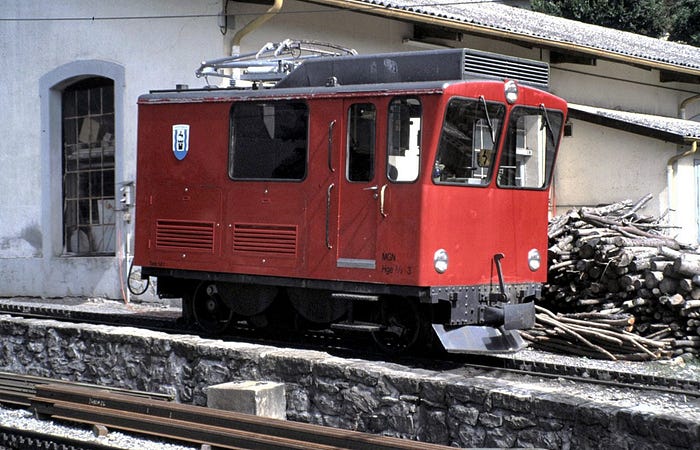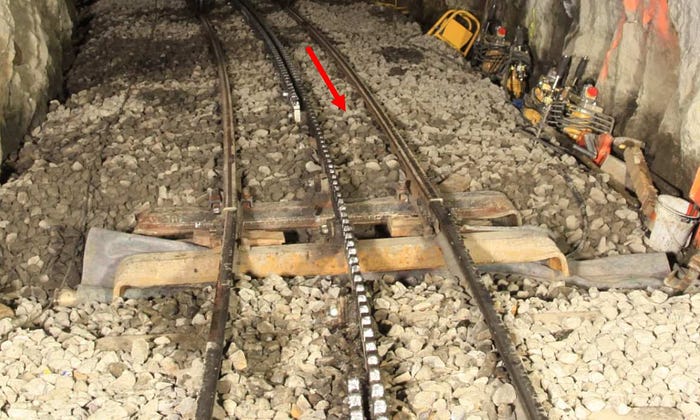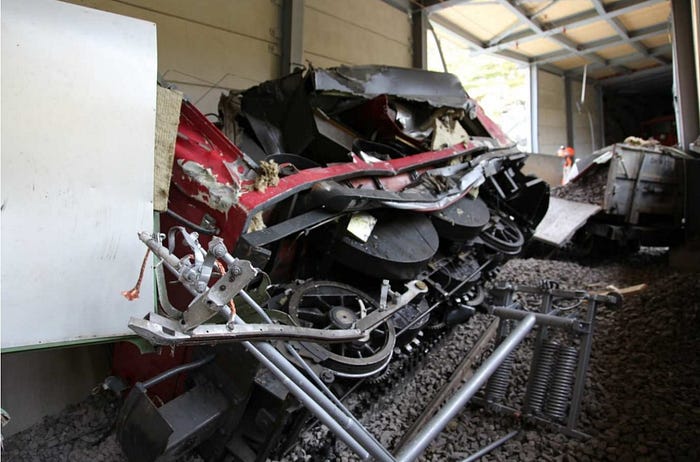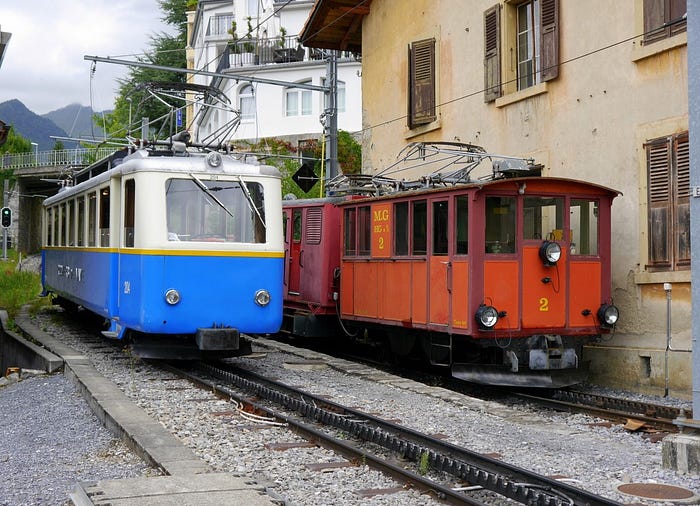Missing Tooth: The 2011 Rochers de Naye (Switzerland) Train Derailment
Please Note: The sources to this were relatively scarce and pretty much all in French, a language I don’t know at all. I did my best with translation software, but it’s possible that some errors slipped through. I apologize for those.

Background
The Rochers de Naye is a 2042m/6699ft high mountain in the Swiss Alps, located in the Canton of Vaud in the southwest of Switzerland 5km/3mi east of Montreux and 61km/38mi southwest of Thun (both measurements in linear distance).

Since 1892 a narrow gauge cogwheel railway connects a station with a hotel and restaurant near the peak with Montreux down on the shore of Lake Geneva. The railway, which was electrified in 1938, uses 10.36km/6.4mi of track in the unusal narrow gauge of 800mm (regular gauge is 1435mm) at an incline of up to 220 permille/22 percent. To manage the incline, which would see any conventional train hopelessly spin its wheels in one place, the MGN (Montreux-Glion-Rochers de Naye) uses the Abt-style cogwheel system for added traction on their entire route.

The system consists of a cogwheel on the driven axle of a locomotive grabbing into a toothed third rail in the center of the track, helping to pull the train up a hill or to slow it on the way down. The drawback of a cogwheel system is that it requires a rather slow speed in order to work safely and for stability locomotives always have to be at the valley-side of the train limiting configuration options. As it winds its way up the mountainside the MGN’s route goes through several tunnels and galleries (artificial tunnels open to one or both sides) for protection against rockfall or avalanches.

The train involved
On the day of the accident HGe 2/2 number 3 was working for a construction crew near the summit station of the line, shuttling into the valley and back with a single ballast car carrying gravel for replaced track. The HGe 2/2 is a two-axle electric locomotive introduced in 1909. The three locomotives were acquired to push passenger trains, freight and maintenance trains along the lower part of the railway before replacing the less capable steam engines when the upper section was electrified in 1938. Each of the three locomotives weight 14 metric tons at 4.8m/16ft long and reached 13kph/8mph. In 1976 number 3 received a new body, now made from steel rather than wood, along with modern lights.

The accident
On the 8th of September 2011 HGe 2/2 number 3 is pushing a freight car loaded with 6m³/211ft³ of gravel up the tracks through the final gallery towards a construction side near the upper end of the gallery. Workers have replaced some track ahead of the portal and the locomotive brings the gravel to put in new ballast around the sleepers. The two workers aboard the train inch the train uphill on the newly laid track, not realizing that a piece of the toothed third rail hasn’t been reinstalled yet. The Abt-system uses two toothed rails side by side, with one rail’s tooth being located opposite the valley between teeth on the other rail. With one of the rails missing the cogwheel-system can’t hold the train. At 10:30am the train stalls out on the hill and begins rolling backwards. Missing the beginning of the properly installed toothed rail the train can’t be stopped, it derails and picks up speed as it rolls backwards through the final gallery. 70m/230ft from where it stalled the train finally stops following the track and the locomotive crashes into the wall of the gallery, punching a hole in the concrete wall and derailing the ballast car as the exposed vertical beams rip the locomotive apart. One of the workers on board is thrown from the train and severely injured, the other gets trapped in the wreckage with severe injuries and has to wait for help to cut him free.

Aftermath
Coworkers of the two injured workers are the first people to reach the wreckage, due to the inaccessible location it takes time for professional responders to arrive. Despite the slow speed the locomotive was destroyed in the derailment with the exposed support structure of the gallery acting like a hook that grabbed the upper section of the body and ripped it backwards, tearing the metal right below the cabin windows. The derailed ballast car has jammed itself in the gallery almost sideways, being locked in place by the collapsed wall, forcing any responders to make their way around the gallery and approach from the valley-side. The worker who was thrown from the locomotive (other sources say he jumped) survives with severe injuries especially to his back and is airlifted to a hospital in Lausanne as soon as the first rescue crew arrives. Working their way through the remains of the locomotive the responders eventually manage to rescue the other worker, he’s taken to hospital and survives but looses and arm in the process (whether during the accident, rescue or at the hospital differs depending on the source). Investigators don’t take long to find the puzzle-pieces that came together to cause the accident. A sizable gap in the toothed rail is impossible to miss for the investigators, the small locomotive had no chance of keeping traction past this point. Workers had temporarily propped up the track on wooden blocks as they waited for the gravel and, presumably unwilling to pull heavy wheelbarrows up the hill they chose to try and get the ballast car as close to the gap in the ballast as they could. In the process of that they ordered the crew to move the train forwards just a little too far.

As the investigation at the site finishes up the wreckage of the locomotive is partially disassembled and taken into the valley for further examination. The first discovery by the investigators is that the speed-recorder of the locomotive was defective and didn’t record the drive up the hill, and that the deadman’s switch, a device intended to ensure the driver is alert and in control, had been disabled. Both these things would usually cause investigations, but they are soon ruled out as contributing factors in the accident at hand. Moving below the locomotive investigators find fresh scratches on the side of the cogwheels, matching similar damage found on the teeth at the lower end of the gap in the third rail.


Further investigation of the track at the construction site reveals that the freshly laid ballast ahead of the gap hadn’t been placed properly, causing the tracks in the turn to lack support and an intended slight banking, being instead level and getting pressed into an outward-banking angle when a train went over them. In short, the workers had been arguably negligent when replacing the track and ballast and should have never allowed the train to move as far up as it did. Stopping the train a few meters short and accepting a slight inconvenience and an increase in the required time would have let the accident never happen. Aside from how needless the injuries suffered by the workers on the train was the accident also took a cultural toll, destroying a fully working historic locomotive.

The report closes with the recommendation to urge workers to better be cautious with how close to a construction site they let trains approach on inclined track, and to ensure that it is made very clear that a single toothed rail can not hold a locomotive. Locomotive number 3 had earlier derailed at Tremblex station (on a level piece of track) when it had been decided that the train could operate with a single toothed rail in place. In that case the cogwheel had slipped out of the toothed rail in a turn, lifting the locomotive up as it hit the next tooth and derailing it. A criminal investigation over negligent cause of bodily harm was started in the aftermath of the derailment, but the exact outcome is unknown. The remains of HGe 2/2 #3 where scrapped within the year, leaving locomotive #2 as the sole survivor of the type. Having received a new body in the style of the original one in the late 80s is was used for historic tourist trains until 2012 when its tasks were limited to construction trains only. In 2013 the MGN received new hybrid locomotives, sending HGe 2/2 #2 into storage at Glion.

_______________________________________________________________
